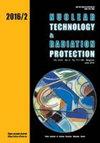医疗重离子设备治疗室诱导放射性对医务人员职业暴露的影响研究
IF 0.9
4区 工程技术
Q3 NUCLEAR SCIENCE & TECHNOLOGY
引用次数: 0
摘要
重离子放射治疗是目前公认的最先进的粒子治疗方法,正在世界范围内得到大力推广和应用。这种方法能在治疗过程中迅速产生辐射并诱发放射性。然而,作为医务人员主要暴露源的诱发放射性,在治疗室使用后并没有消失。本研究采用实验测量与蒙特卡罗模拟相结合的方法,研究了甘肃省武威肿瘤医院治疗室(均匀扫描模式)中该诱导放射性的特征、剂量率分布及其对医护人员的影响。研究发现,医务人员的照射剂量主要与单次照射的受照患者和长期照射的受照光束输送系统有关。主要放射性核素的半衰期在单次辐照下为几分钟至数十分钟,在长期辐照下为数十天至数百天。主要的放射性核素贡献者是15O、11C、176Ta和177W。我们还估计了医疗室医务人员的个人剂量与他们的工作模式之间的关系。结果表明,在现行模型下,医务人员在水平治疗方向的最大年暴露剂量为0.728 mSv。我们假设适当增加患者的治疗可以在不改变每天总治疗时间的情况下将医务人员的年暴露剂量降低到0.650 mSv。最后,提出了一些减少医务人员接触有害辐射的建议。本文章由计算机程序翻译,如有差异,请以英文原文为准。
Study on occupational exposure of medical staff caused by induced radioactivity in the treatment room of medical heavy-ion facility
Heavy-ion radiotherapy is currently recognized as the most advanced particle therapy method and is being vigorously promoted and applied worldwide. This method can rapidly generate radiation and induce radioactivity during treatment. However, the induced radioactivity, which is the primary source of exposure for medical staff, does not disappear following therapeutic application in the treatment room. In this study, we investigated the characteristics, dose rate distribution, and impact of this induced radioactivity on medical staff in the treatment room (uniform scanning mode) at Gansu Wuwei Tumor Hospital using experimental measurement and Monte Carlo simulation. We found that the exposure dose experienced by medical staff is predominantly related to the irradiated patients for single irradiation and the irradiated beam delivery system for long-term irradiation. The half-lives of the main radionuclides ranged from a few minutes to tens of minutes for single irradiation and from tens of days to hundreds of days for long-term irradiation. The primary radionuclide contributors are 15O, 11C, 176Ta, and 177W. We also estimated the personal dose experienced by the medical staff in the treatment room in relation to their working patterns. The results showed that the maximum annual exposure dose of medical staff in the horizontal treatment direction under the current model was 0.728 mSv. We hypothesized that an appropriate increase in the patient's treatment could reduce the annual exposure dose of medical staff to 0.650 mSv without changing the total treatment time per day. Finally, some suggestions were made to reduce the exposure of medical staff to unwanted radiation.
求助全文
通过发布文献求助,成功后即可免费获取论文全文。
去求助
来源期刊

Nuclear Technology & Radiation Protection
NUCLEAR SCIENCE & TECHNOLOGY-
CiteScore
2.00
自引率
41.70%
发文量
10
审稿时长
6-12 weeks
期刊介绍:
Nuclear Technology & Radiation Protection is an international scientific journal covering the wide range of disciplines involved in nuclear science and technology as well as in the field of radiation protection. The journal is open for scientific papers, short papers, review articles, and technical papers dealing with nuclear power, research reactors, accelerators, nuclear materials, waste management, radiation measurements, and environmental problems. However, basic reactor physics and design, particle and radiation transport theory, and development of numerical methods and codes will also be important aspects of the editorial policy.
 求助内容:
求助内容: 应助结果提醒方式:
应助结果提醒方式:


